| Article ID | Journal | Published Year | Pages | File Type |
|---|---|---|---|---|
| 4730300 | Journal of Asian Earth Sciences | 2015 | 15 Pages |
•Qinling Orogen was built through three-episode collision between the NCB and SCB.•Neoproterozoic southward subduction and accretion took place along the LLF and KPS.•Paleozoic northward subduction and accretion occurred along the Shangdan suture.•Late Triassic accretion occurred along the Mianlue suture between the SQB and SCB.
The Qinling Orogen was built through collision between the North China and South China Blocks. Previous detailed geological, geochemical and geochronological investigations revealed that the mountain range can be divided into four tectonic units with distinct tectono-lithostratigraphy, which are, from north to south, the southern sector of the North China Block, North Qinling Belt, South Qinling Belt and northern sector of the South China Block, separated by the Kuanping, Shangdan and Mianlue sutures. According to the petrology, geochemistry and geochronology of ophiolitic mélanges and related magmatic rocks, as well as the features of sedimentary units, we think that the North China Block, the North Qinling Belt and the South China Block were originally independent continental units while the South Qinling Belt had been the northern part of the South China Block. These units experienced three episodes of accretionary tectonic processes and amalgamation from south to north.The Neoproterozoic accretion took place along the Luonan-Luanchuan Fault and Kuanping ophiolitic mélange belt as a result of southward subduction and subsequent collision between the North Qinling and North China Blocks during ca. 1.0–0.8 Ga related to the formation of the supercontinent of Rodinia. The Paleozoic accretion occurred along the Shangdan suture resulted from northward subduction of oceanic lithosphere in the Early Paleozoic and subsequent continental subduction in the Late Paleozoic. Late Triassic accretion took place along the Mianlue suture between the South Qinling and South China Blocks due to northward subduction of the Mianlue oceanic lithosphere during the Permian–Early Triassic and subsequent collision in the Late Triassic. After the Late Triassic collision along the Mianlue suture the whole Qinling Mountain range entered the phase of intense intracontinental deformation.
